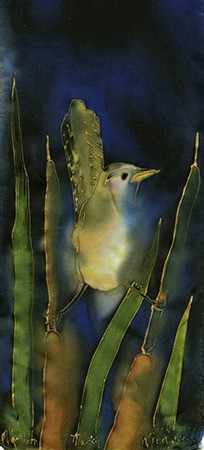A series of brightly colored silk panels created by local artist Linda Vorobik have begun fluttering over the remains of a seasonal stream that once flowed through the grounds of Lopez Center. Gracefully painted with images of birds, dragonflies, reeds and flowers, the silk panels recall a time before streets and businesses, when Lopez Island’s “Urban Growth Area” was still mainly wetlands and lagoons.
“My aim is to increase local appreciation for the diversity of and beauty of natural wetlands, and how selective restoration projects can not only benefit native species and increase natural plant and wildlife habitat, but it can enrich and beautify our neighborhoods,” Vorobik says.
Vorobik’s Silk Stream is the second in a series of public art installations sponsored by the nonprofit conservation laboratory Kwiaht called Village at the Edge of the Sea, which focuses on the protection of water quality and wildlife in Fisherman Bay. The first installation was Nancy Bingham’s sculpture Raven Woman, at the water tower park.
Village at the Edge of the Sea recalls the history of wetlands and waterways in Lopez Village, from 19th century dikes designed to build salt hay fields, to the network of drainage ditches that barely succeed in keeping the Village from flooding in winter storms today. Dikes, ditches and diversions have left a sea of lawn grass, and where water still collects seasonally, invasive European reed canarygrass.
“Paving, buried pipes and barely vegetated ditches next to the roads are all designed to move water to the bay as quickly as possible,” says Kwiaht director Russel Barsh. “Why send contaminants straight into Fisherman Bay, when we could use runoff to build parks, using species that can degrade, or at least filter out the contaminants?”
In the progression of panels that form Silk Stream, Vorobik anticipates the recovery of native wetlands, and the return of native species. Her art invites the community to begin replacing paving and sewer pipes with gardens, frog pools and sloughs filled with rushes and cattails.
As a first step, Kwiaht will build a demonstration street-side bio-remedial garden in the Village with the help of local students, and a grant for materials from the Atlanta based Captain Planet Foundation. It will use native wetland plants to detain copper, a major threat to fish. Earlier this year, Kwiaht landscape ecologist Nathan Hodges and Orcas Island students built a demonstration “biomachine” within an Eastsound parking lot that uses plants and fungi to break down motor oil.
Silk Stream panels can be viewed on the Lopez Center grounds through August 30. They will be at Greene Partners: Architecture and Design, 2585 Fisherman Bay Road for the Studio Tour on August 31 and September 1; travel around Lopez Village from September 2 to19; and return to Lopez Center for the Lopez Artist Guild Opening on September 20, where it will be joined by other works celebrating local wetlands.
You can learn more about Silk Stream at www.VorobikBotanicalArt.com.



